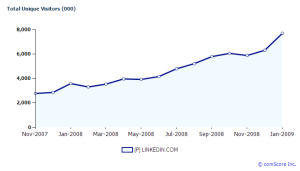Hidden signals in Social Software
The book, The Wisdom of the Crowds, by James Surowiecki talks about the aggregation of information in groups and how this can make better decisions than individuals within certain bounds. The ubiquitous nature of social software, the number of people using it and the degree to with which we become “Linked In” gives us a real time handle on the crowds and what they are doing. Systems like Twitter target this kind of behaviour directly; a pure aggregate of a stream of consciousness, while other systems like Linked In address it tangentially through behaviour. I posted the following on Twitter back on the 30th of Jan.
A good layoff indicator is LinkedIn, my network activity is way up — 1st action when laid off is to connect and seek recommendations.
This was just based on patterns I’d observed through my own network of both internal and external colleagues responding to the unfortunate events surrounding the economic times. It was with interest today that I saw this article on TechCrunch which shows that LinkedIn grew 22% in January (over December) and minutes on the site doubled in the same month. I may have contributed to some of those minutes myself.

Most of us are already well aware that we leave a footprint on any social networking site, and in some instances, may come to regret that photo we posted on facebook. What I find more fascinating however is how these sites are generating new signals and measures that over time could be used to perhaps supplement or replace existing messages. One person updating their resume is not newsworthy — everyone updating it sends a strong message about job security. Good systems are those which can make visible these hidden messages and signals. What hidden signals are you observing in other systems which provide insight (of any kind)?

